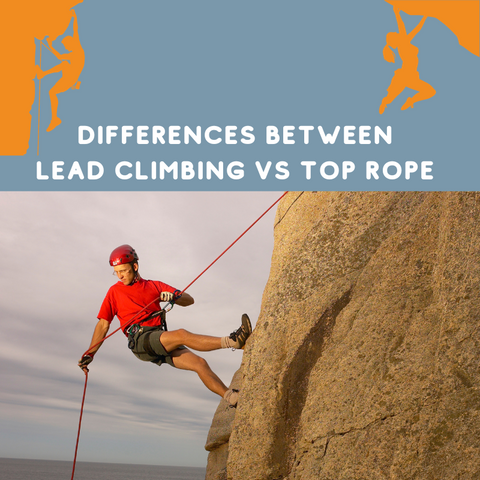
When venturing into the rock climbing world, knowing the differences between lead climbing and top-roping is essential, and you often need a little help when telling the two apart. So, what's the difference between lead climbing vs top rope climbing?
Below, we’ve compiled an in-depth guide to the five key differences between lead climbing vs top rope climbing.
Lead Climbing vs Top Rope
Before we get into the primary differences between lead climbing vs top rope, let’s get to know a little more about these two forms of rock climbing.
Lead Climbing: Defined

Lead climbing is when you climb with a rope and clip with attached protection along your climbing route to protect yourself from a fall. Considered a form of sport climbing, rock climbers will have quickdraws fastened to their harness, having one side fastened to the bolt and the other side attached to the rope.
You can perform lead climbing outdoors or at an indoor climbing gym. When lead climbing indoors, the quickdraws are already in place, and the bolts are correctly attached. Lead climbing is considered more dangerous than top rope climbing.
Top Rope Climbing: Defined
Just as the name suggests, when top-roping, you'll climb a tall wall while attached to a rope for added safety during your entire climb. Your climbing rope will be connected to an anchor above the climbing wall. While top-roping, you'll notice significant improvements in your strength, climbing abilities, and techniques.
As you may already know, your endurance will be tested when top-roping, leaving your arm muscles hurting after a good climb. As previously mentioned, top-roping is a type of rock climbing where you’ll be supported by a rope that runs up and down the wall.

The rope that runs through the anchor will be controlled by your belayer, who will be below you as you climb. Top-roping is considered to be one of the more accessible forms of climbing when compared to lead climbing.
If someone wants to lead climb, the climber should attach the rope to the anchors using both quickdraws and carabiners. While there are other forms of rock climbing, they are typically more dangerous than top-roping, which doesn’t require you to clip anchors.
5 Main Differences Between Lead Climbing vs Top Rope
Below are the five main differences between lead climbing vs top rope climbing.
1. Belay Technique
One of the primary differences regarding lead climbing and top rope is how essential your belayer is when lead climbing. Top roping is a more manageable form of rock climbing and can be taught in as little as fifteen minutes to anyone interested.
However, when lead climbing, this form of climbing is much more complicated and requires your belayer to be more active in the climb. Your belayer should be skilled and attentive to ensure you avoid injuries while lead climbing. To avoid injury, you should choose your belayer wisely.
Ensure you’re choosing an experienced belayer who can not only catch you in case of a fall but also safely. This is important because you want to avoid the rope becoming too tight to avoid a pendulum injury and to avoid hitting the ground.
2. Difficulty
As previously mentioned, many advanced climbers refer to lead climbing as more complex compared to top-roping. When you begin lead climbing, you should go down around two grades from your maximum level. Once you become more advanced and learn more techniques, you'll build your tolerance.
The rewards associated with lead climbing are priceless, which we’ll cover as we get to recognition.
3. Skill Level
As mentioned earlier, lead climbing is considered riskier than top rope climbing. If you fall when top roping, you're caught instantly, and the risk that anything will happen is slim. However, if you fall while lead climbing, you can fall anywhere up to thirty feet.
When falling from such a high distance, this leaves a lot of room for injuries. Some injuries you can run into are toe tucks, pendulums, and whiplash. Since there’s a higher risk of injury, you should start slowly when top roping.
While top roping, only do what you can manage and pay more attention to your foot placement to avoid toe tuck.
4. Recognition
Now, to the recognition aspect of rock climbing, which refers to the reward part of lead climbing. Lead climbing is a much more rewarding type of climb. Rock climbing in itself can be rewarding no matter what way you look at it.
However, according to experienced climbers, until you’ve achieved a lead climbing route, you haven’t seen anything! Top-roping, on the other hand, is an excellent form of climbing if you want to practice, but lead climbing is where the actual achievements remain.
5. Applicability
If the only form of rock climbing you know how to do is top-roping, you'll have the choice of using indoor climbing gyms or outdoor crags with a partner who sets up your climbing route on top rope.
In the majority of areas, you're required to know how to lead climb before you can begin climbing. If you're climbing in an outdoor area, you'll need someone to be the leader in the first climbing route since there's no rope involved.
Lead climbing is an excellent form of climbing to prepare you for various sports, too! If mountain sports are the thing, lead climbing is essential to help you prepare.
Lead Climbing vs Top Rope: FAQ
1. Is lead climbing harder than top rope?
When lead climbing, more endurance is required than top roping since you need to carry more gear and don't have a tight rope to rely on for balance.
2. Is top-roping lead climbing?
There are two forms of rope climbing, which involve top-roping and lead climbing. Top-roping requires a climber and a belayer on the ground.
3. Is top-roping more dangerous than lead climbing?
Lead climbing is considered more dangerous than top-roping because of the risk of more significant falls since your protection is below you instead of above you.
